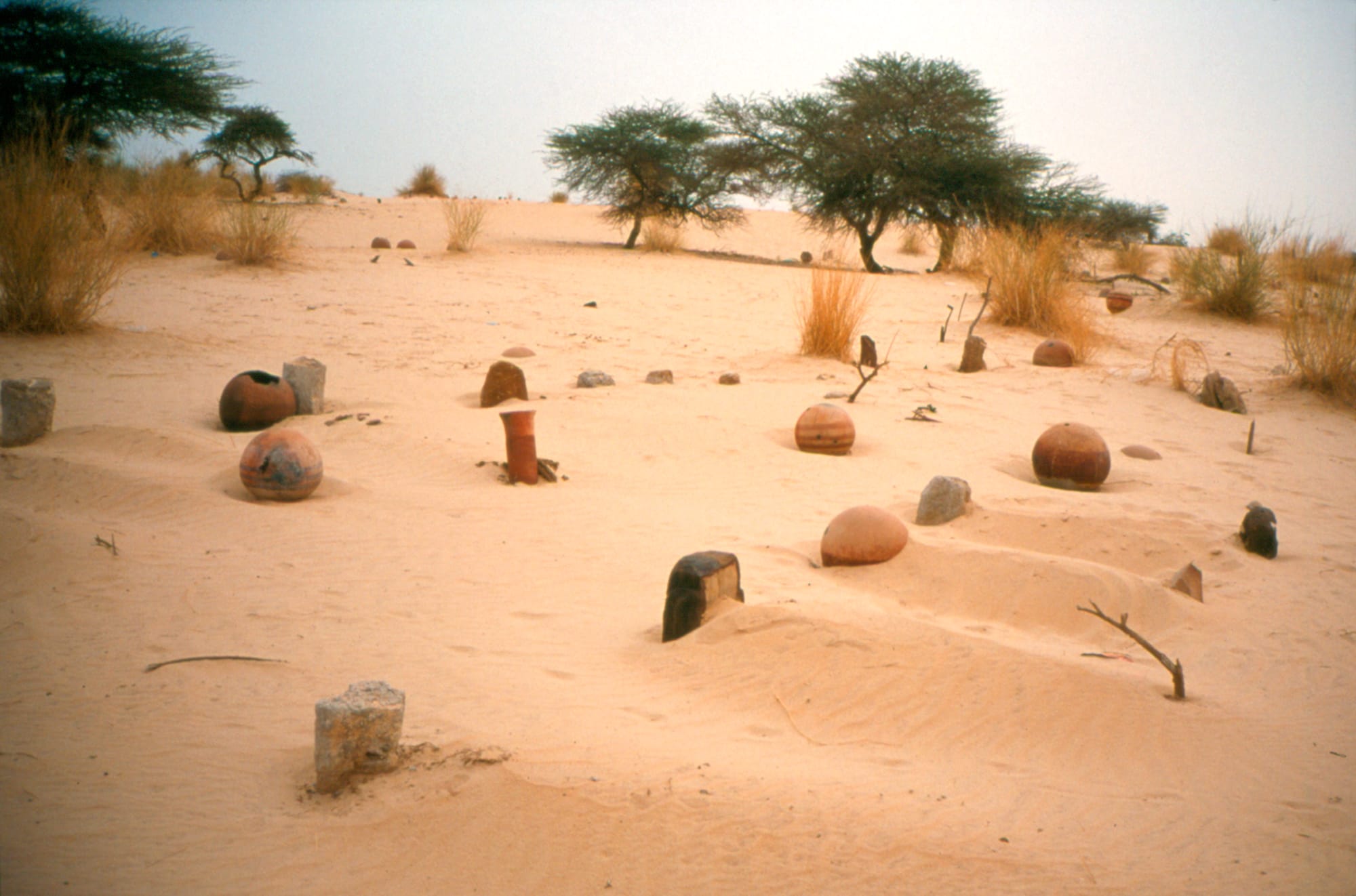Overview
Marian Goodman Gallery is delighted to announce the occasion of a special exhibition of new photographs by Gabriel Orozco. The exhibition will open on Thursday, November 14th and will be on view in the South Gallery through Saturday, January 4, 2003.
In this new series of photographs taken in July on a trip to Mali, Orozco continues his concerns with sculpture and landscape, presenting the unexpected but mesmerizing side of the everyday. The works concentrate on objects, phenomena, erosion, materiality, and the organic. A well, a field, a stone path, a town, a mosque, a cemetery in legendary Timbuktu, the mysterious city on the trans-Saharan caravan route – spaces with a complex history but presented directly, with their surprising and contemporary aspect revealed.
For over a decade Orozco's work has addressed the possibilities inherent in the nexus of sculpture and photography. In his work, the ambiguity that exists between object and image is full of potential: the photograph can result from contingencies of the environment, from transient encounters between the artist and the materials of every day life, or from a series of sculptural strategies. Orozco's photographs are vehicles of transport for the ephemeral—constituent of transit, movement, time, and space.
Gabriel Orozco: New Photographs
November 14, 2002 - January 4, 2003
Opening Reception: Thursday, November 14, 6-8 pm
Marian Goodman Gallery is delighted to announce the occasion of a special exhibition of new photographs by Gabriel Orozco. The exhibition will open on Thursday, November 14th and will be on view in the South Gallery through Saturday, January 4, 2003.
In this new series of photographs taken in July on a trip to Mali, Orozco continues his concerns with sculpture and landscape, presenting the unexpected but mesmerizing side of the everyday. The works concentrate on objects, phenomena, erosion, materiality, and the organic. A well, a field, a stone path, a town, a mosque, a cemetery in legendary Timbuktu, the mysterious city on the trans-Saharan caravan route – spaces with a complex history but presented directly, with their surprising and contemporary aspect revealed.
For over a decade Orozco's work has addressed the possibilities inherent in the nexus of sculpture and photography. In his work, the ambiguity that exists between object and image is full of potential: the photograph can result from contingencies of the environment, from transient encounters between the artist and the materials of every day life, or from a series of sculptural strategies. Orozco's photographs are vehicles of transport for the ephemeral—constituent of transit, movement, time, and space.
In this exhibition, the choice of an enlarged format permits an attention to matter and scale and allows a focussed perception and a sense of wholeness in the artist's working method. Total Perception, a photograph of the mosque of Timbuktu, reveals a space of comprehension or possible illumination. In the six images of Cemetery, the viewer is confronted with an essential human landscape. A link can be made between these photographs and his prior installation, Cazuelas (Beginnings), made for Documenta 11 in Kassel, in that both are articulations of receptacles and spaces for transportation, preservation, and survival--constant concerns in the work. The exhibition will include two other photographs taken earlier in Mexico and recently printed: Toilet and Rubbed Bricks. These images capture both the uncanny visual moment and the intervention and documentation with found materials. In this new series of photographs, Orozco continues his engagement with nature and the social environment, implicating and shifting the viewer's relationship to vistas, objects, and our own perceptions.
Gabriel Orozco's work is currently on view in Moving Pictures at the Solomon R. Guggenheim Museum through January 12th; at the Serpentine Gallery, London in En Route through October 27th; at the Pompidou Center, Paris, in Sonic Process; and at the Kunsthaus Zurich, Switzerland, in Public Affairs, through December 1st. His work was most recently exhibited at Documenta 11, Kassel, this past summer.
One-man exhibitions in the U.S. have been held at The Philadelphia Museum of Art, The Museum of Modern Art, and the MCA, Chicago. Abroad, solo shows include such venues as: Art Angel Projects, London; the Kunsthalle Zurich (which travelled to The ICA, London and the Staalichen Museum am Kulturforum, Berlin).; Portikus, Frankfurt; ARC/Musée Nacionale d'Art Moderne de la Ville de Paris; the Stedelijk Museum, Amsterdam; and the Kanaal Art Foundation, Kortrujk, Belgium. A retrospective of his work was shown in 2000-2001 at The Museum of Contemporary Art, Los Angeles, and toured to two institutions in Mexico, the Museo Internacional Rufino Tamayo, Mexico City and the Museo de Arte Contemporaneo de Monterey, Monterey. His work has been in several important group exhibitions, including Documenta 11 and Documenta 10, Kassel; the 2001 Yokohama International Triennial of Contemporary Art, Japan; the Istanbul Biennial, Turkey; Ars 01 at the Museum of Contemporary Art, Helsinki; the 1999 Carnegie International, Pittsburgh; Skulptur Projekte, Münster; and the 1997 and 1995 Whitney Biennals, New York.
Born in Jalapa, Veracruz in 1962, Gabriel Orozco studied at Escuela Nacional de Arte Plasticas, U.N.A.M in Mexico City between 1981 and 1984, and later in Spain at Ciculo de Bellas Artes, Madrid from 1986 to 1987. In 1995 he was a DAAD artist in residence in Berlin, Germany.

















